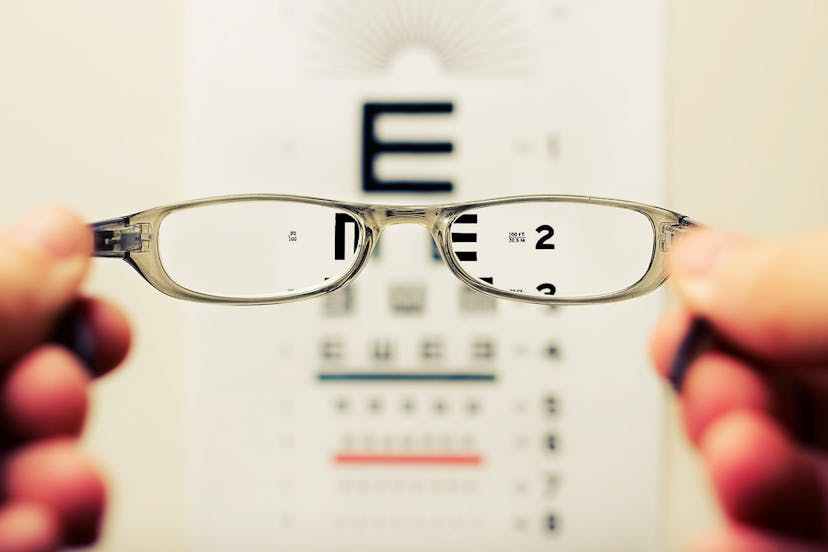
Does Everyone Need Reading Glasses After 40?
As you start creeping towards your 40s, many adults find that they start to struggle to see clearly at close distances.
More specifically when they are reading or on a computer. This is extremely common in those aged between 41-60. It is completely normal, as we age; the eye’s ability to focus becomes weaker.
This is called Presbyopia and will continue to develop over time. The average reading glasses age varies, but most people find they need them once they’ve hit middle age.
Unfortunately, there is no escape, even if you’ve had perfect vision. Those who are near-sighted will also start to notice that their vision blurs when they wear their usual glasses and/or contact lenses that had been prescribed to correct their distance vision.
If you want to know the ins and outs of why most people need reading glasses at 40 and over, this article will explain why.

What Are The Symptoms Of Presbyopia?
Presbyopia usually develops over time, which explains why the average reading glasses age tends to be over 40. The symptoms of presbyopia include:
- You may find that all of a sudden you have to hold your favourite book at arm’s length to see the words clearly.
- You may find that rather than your glasses helping, you are instead taking them off to see things better up close.
- Words are appear blurry; especially in poorly lit environments are signs that show us that action needs to be taken.
- You may also find that you are having more frequent headaches, strain in your eyes and fatigue that makes reading and near-vision tasks more tiring and uncomfortable.
What Age Do You Need Reading Glasses?
When you’re younger, the lens inside each of your eyes is considered to be flexible and focuses when you look at objects up close.
The lenses in our eyes stiffen with age and thicken, so it is harder to focus on something that is up close. Due to this, people often need reading glasses at 40 and older.
When you do hit the age of 40, it is a good idea to visit your optician at least every 2 years so that your eye health can be monitored. If you need to change your prescription this can be done, that way the struggle to do things that require seeing at a close distance is eliminated.
Reading glasses are a popular option that helps combat the effects of presbyopia and is also a quick and easy option to turn to. Many people need reading glasses at 40 and over, so it’s extremely common and nothing to be embarrassed about.
How Can Presbyond Help Instead?
Alternatively, some people consider Presbyond. This is a better option for those who are tired of wearing contacts and glasses and the procedure is quick and simple.
Presbyond is a laser vision correction procedure that increases the depth of field in each eye so that there is a continuum from near through to intermediate to a distance where objects are perceived clearly without any aid.
It has two components, the surgery itself and most importantly, the brain learning how to adapt to this new vision. When successful, this adaptation happens within a few weeks or months at most.
But, to make sure that this will be the case, a trial can be done to ensure that your brain will be able to cope.

14 Facts About Why Presbyopia Occurs
- Presbyopia: This is a natural age-related condition that affects the eye's ability to focus on close objects. It typically starts to become noticeable around the age of 40.
- Loss of Elasticity: The lens of the eye loses its flexibility and elasticity as a person ages. This makes it harder for the eye to adjust and focus on objects up close.
- Muscle Weakness: The ciliary muscles, which are responsible for changing the shape of the lens to focus on objects at different distances, also weaken with age. This weakening makes it harder to focus on close objects.
- Near Point of Accommodation: This is the closest point at which the eye can focus clearly. In individuals with presbyopia, this point moves farther away, making it difficult to focus on close-up tasks like reading.
- Symptom Progression: The symptoms of presbyopia tend to progress over time. Initially, people might notice difficulty reading fine print, but eventually, it can affect tasks like using a computer or even seeing objects clearly at arm's length.
- Universal Condition: Presbyopia is a common condition that affects nearly everyone as they age. It is estimated that by the age of 50, almost everyone will experience some degree of presbyopia.
- Not Correctable by LASIK: Unlike other refractive errors like nearsightedness, farsightedness, and astigmatism, presbyopia is not easily corrected through surgical means like LASIK. Reading glasses or multifocal lenses are typically the best solution.
- Different from Other Vision Conditions: Presbyopia is different from conditions like nearsightedness (myopia), farsightedness (hypermetropia), and astigmatism, which are caused by the shape of the eye or cornea.
- Corrective Lenses: Reading glasses are the most common solution for presbyopia. They are designed to provide additional focusing power for close-up tasks.
- Bifocals and Multifocals: In addition to reading glasses, bifocals and multifocals are also used to correct presbyopia. These lenses have different regions for focusing at various distances.
- Contact Lenses: Multifocal contact lenses are available for those who prefer not to wear glasses. These work in a similar way to multifocal eyeglasses.
- Monovision: Some people opt for a monovision approach, where one eye is corrected for distance vision and the other for close-up tasks. This can be achieved with contact lenses or through refractive surgery.
- Progressive Lenses: These are similar to bifocals or trifocals but without the visible lines. They provide a seamless transition between the different focusing distances.
- Regular Eye Exams: As presbyopia progresses, it's important to have regular eye exams to monitor changes in vision and adjust corrective lenses as needed.
Remember, presbyopia is a natural part of the ageing process, and it's important to seek the advice of an eye care professional to determine the best solution for your individual needs.
Exploring Presbyond With My-iClinic
Presbyopia is completely normal and we’re all going to have to deal with it sometimes after we turn 40. There are multiple options out there including glasses, contacts and surgery.
If you’ve found yourself at the ‘reading glasses’ age and would like to correct your vision in a more permanent way, Presbyond may be a more suitable option for you.
If you are beginning to notice signs and symptoms or you have had enough of living with reading glasses, book a consultation with our surgeon, Mr John Bolger.
At this consultation, we can give your eyes an examination and you can discuss your options for the best presbyopia treatment.
Find out more by Speaking to our team









